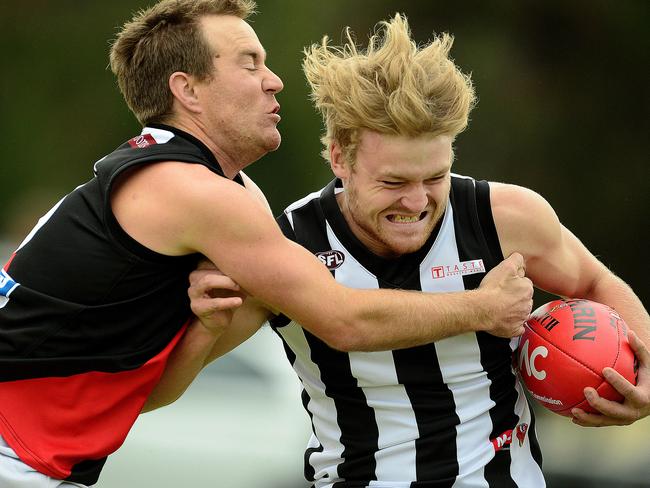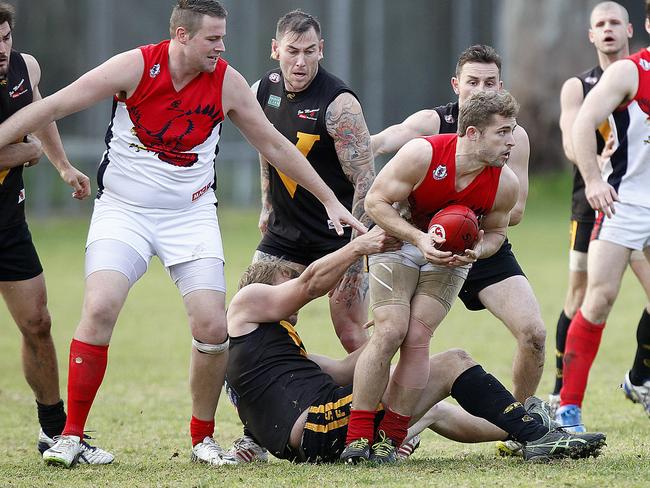Southern Football League clubs split on how to make competition more even after string of heavy losses
WHEN losing by 10 goals or more becomes the norm, not an exception is it time to swap competition? Some in an Adelaide footy league say it is, but others don’t agree. TAKE OUR POLL

South
Don't miss out on the headlines from South . Followed categories will be added to My News.
SOUTHERN Football League clubs are split on whether the competition should divide into two divisions to improve the quality of games.
Debate on how to make the league more even was reignited when five matches were decided by more than 100 points, including one by 213, on May 16.
The results increased this season’s average losing margin to 66 points.
The average losing margin has topped 10 goals in each of the past five years.
Four of the 13 club presidents polled last week favoured splitting into two divisions to improve the standard.
Six wanted to maintain the status quo, while three would consider a proposal to split the competition but would not commit either way.
Marion president Min Adams said he had voiced concerns to the league about the gulf between the top and bottom sides.
“In my opinion it’s got to be two divisions but they won’t listen to me,” Adams said.
“You saw the results last week — it’s terrible and something’s got to be done.”
The Rams have finished no higher than 12th in the past five years and have suffered two 100-point thrashings this season.
Adams said losing heavily made it difficult to recruit.
“Who wants to play for a team getting belted by 100 points all the time?”
O’Sullivan Beach-Lonsdale president David Schultz, whose club won back-to-back wooden spoons in 2014-15, said the thrashings were “not a good look for the competition”.
“Two divisions would be better for the competition because it’s going to eliminate a lot of the floggings,” Schultz said.

Morphett Vale president Don Markwick said splitting the league would ensure closer contests and bigger crowds.
He said some supporters did not attend games against struggling clubs because they expected them to be one-sided.
“If it’s Aldinga, they might go fishing or do something else, which means you don’t have as many coming to watch, which affects your bar, canteen and gate,” Markwick said.
There has been ongoing debate about reverting to two levels since the league came together in one division in 2001.
It almost came to a head in 2012 when Brighton threatened to leave the SFL because it believed lopsided wins against struggling teams were affecting home crowds and revenue, only for the club to back down.
Last season 35 games were decided by more than 100 points, six by at least 200 and one in excess of 300 points, while long-time battlers Aldinga, Marion and O’Sullivan Beach-Lonsdale have continued to struggle.
A split would need the SFL board’s approval before being endorsed across A and B grades, as well as by junior (under-18, under-16 and under-14) ranks.
But Hackham president Graham Thompson said two divisions was not the answer because second tier clubs would lose players and sponsors to top flight rivals.
“I don’t know how you go picking up sponsors if you’re in the second division,” Thompson said.
Flagstaff Hill president Brett Charlesworth said the two division model “looked good in theory” but was fraught with potential problems.
“A junior team might drop to division two because their seniors might not be performing but the juniors are performing,” Charlesworth said.
“That penalises them and that’s just one small example the simple model put forward doesn’t address.”

Brighton president Kym Steer and Aldinga president Danny Wilde said their clubs would look at any proposals to improve the competition.
The chairman of the SFL’s future directions committee, Gary Davenport, said the league needed to add teams from rival associations before it considered splitting into two divisions.
The SFL has 15 teams and traditionally five grades play at the same venue on Saturdays.
But some clubs do not have junior teams, which Davenport said made scheduling games difficult unless the league expanded.
He said the SFL returned to one division in 2001 because the second tier did not have a junior competition.
“While we’ve got 15 clubs it (two divisions) is not the right way to go,” Davenport said.
“If we put a mechanism in place to get to 16, maybe 18 or 20, which would be an ideal number, two divisions would be a shoo-in.”
Davenport said it was “obvious” having two divisions would lead to more even competition.
He said the league needed to reduce the number of junior grades from three to two to entice clubs from neighbouring associations to join.
That proposal was knocked back last year.
“It’s a lot easier to field two junior sides than three,” Davenport said.
The SFL formed the future directions committee in May 2012 to discuss ways to improve the competition.
SFL president Craig Warman said the league was happy to consider the two-tier discussion.
“We’re always open to that sort of question,” Warman said.
“But with 15 clubs, where do you make the split?
“The biggest fear the clubs have is if you go to a two-division situation the second division teams will be pillaged.”
Warman described the round seven results, which included five losses by more than 100 points, as a shock to league officials.
But he defended the standard of the competition, saying thrashings were not just confined to the SFL.
HERE’S WHAT THE CLUBS SAID: TWO DIVISIONS OR ONE?
ALDINGA: would consider a proposal
BRIGHTON: would consider a proposal
CHRISTIES Beach: one
COVE: one
EDWARDSTOWN: would consider a proposal
FLAGSTAFF Hill: one
HACKHAM: one
HAPPY Valley: one
MARION: two
MORPHETT Vale: two
MORPHETTVILLE Park: one
NOARLUNGA: could not be reached for comment
O’SULLIVAN Beach-Lonsdale: two
PORT Noarlunga: could not be reached for comment
REYNELLA: two — but did question how it would work
HEAVIEST SFL DEFEATS
AVERAGE LOSING MARGIN
2015: 66.9 points * (after to round eight)
2014: 72.5
2013: 65.6
2012: 76
2011: 80.7
100-POINT LOSSES
2015: 12 * (after round eight)
2014: 35
2013: 32
2012: 46
2011: 43
200-POINT LOSSES
2015: 1 * (after round eight)
2014: 6
2013: 3
2012: 9
2011: 11
300-POINT LOSSES
2015: 0 * (after round eight)
2014: 1
2013: 0
2012: 1
2011: 1
- There are 135 games each season



